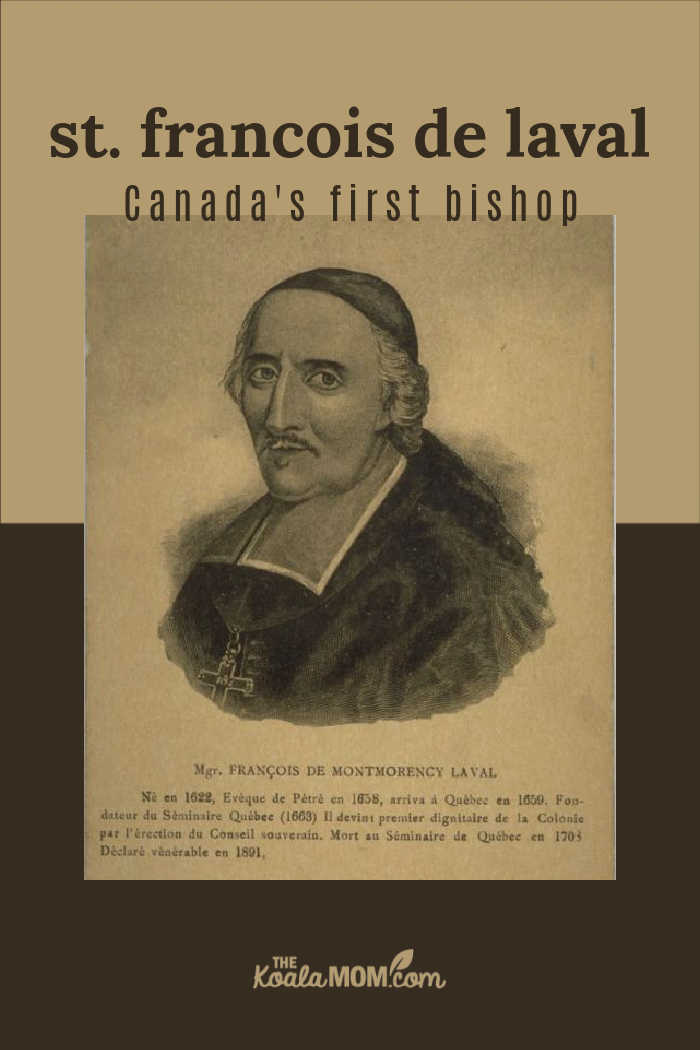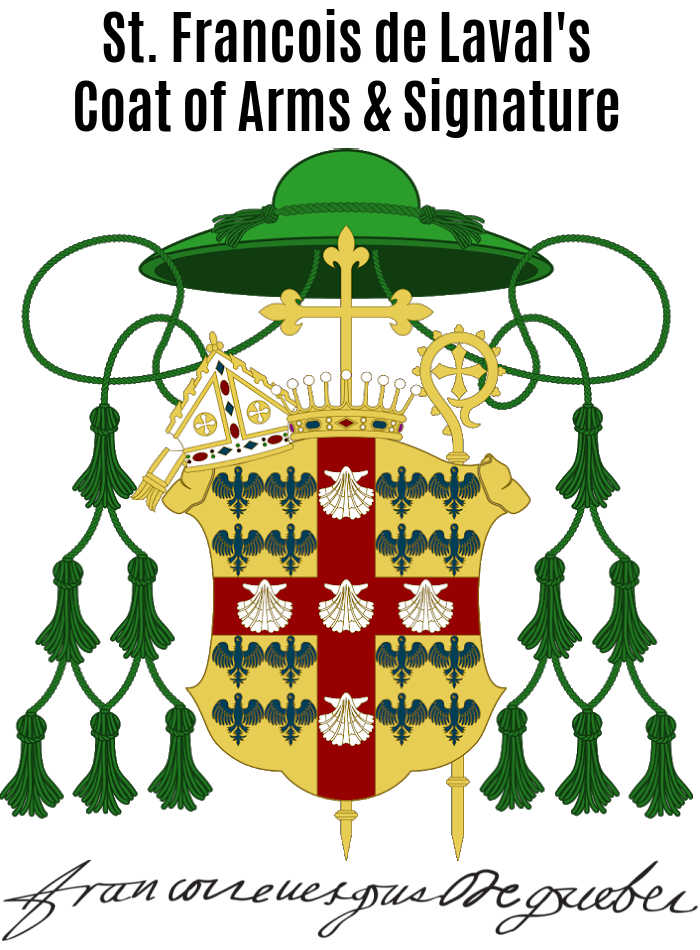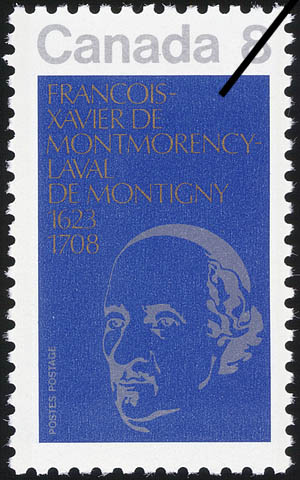May 6 is the feast day of Canada’s first bishop, St. Francois de Laval. He founded schools, traveled vast distances to support his parishioners, gave generously to the poor, and worked tirelessly to spread the Good News through North America. This spiritual giant left a deep legacy of faith not only to Quebec but to all of Canada. He was canonized in 2014 by Pope Francis.

St. Francois de Laval’s Childhood
Francis-Xavier de Montmorency-Laval was born in France in 1623. His family was noble but not wealthy. Francois had five brothers and two sisters; one of his brothers became a Benedictine Monk and one of his sisters became a nun. His mother was a pious, generous woman who set an example of caring for the less fortunate.
As a boy, St. Francois joined the Congregation of the Holy Virgin, a society that encouraged regular prayer and religious practices. At age 8, he received the tonsure and took minor orders before attending a Jesuit college. Here he rubbed shoulders with many sons of the elites of France, but also heard reports of the Jesuit missions to the Hurons of North America. His time here deepened his desire to be a priest and also piqued his interest in the Canadian missions.
God alone knows how much I am indebted to your Society [the Jesuits], which warmed me in its breast when I was a child, nourished me with its salutary doctrine in my youth, and has not ceased since then to encourage and guide me. . . . [The Jesuits] taught me to love God and have been my guides in the path of salvation and the Christian virtues. . . .” ~ St. Francois de Laval
Francois’ father died when he was thirteen, leaving the family finances in a precarious state. The following year, Francois’s uncle, the Bishop of Evreux, appointed him canon at the cathedral, which provided him with an income to support his further education. He graduated at age 19 and went on to study philosophy and theology in Paris. Soon after, both his older brothers died in battle, leaving him the head of his family.
Despite pressure from his mother, the Bishop of Evreux and other family members, Francois refused to renounce his calling to the priesthood. Instead, he helped his mother settle the family affairs and then transferred his inheritance or rights as eldest son to his next-youngest brother. Then he returned to Paris to complete his studies. On May 1 in 1647, at the age of 24, he was ordained a priest.
St. Francois de Laval’s Priestly Work
Soon after his ordination, Father Laval resigned his position as canon and was appointed as archdeacon of the diocese. As archdeacon, he was responsible for nearly 160 parishes and chapels. He worked to establish order in the parishes, help the poor, care for the sick, and carry out other charitable duties.
One of his fellow priests said, “the regularity of his visits, his fervor in carrying them out, the improvements that he effected and the order that he established in the parishes, the relief of the poor, his application to all sorts of good works, all these things indicated clearly that although he was not a bishop, he had the mind and ability of one and that there were no services that the church could not expect from such a great person.”
What Father Francois de Laval really wanted to do was to become a missionary, however. In 1654, he resigned from his post as archdeacon to apply for a position as a vicar apostolic to Indochina. He spent over a year in Rome, awaiting his appointment. However, politics caused the mission to fall through. Father Laval was left a free man, and chose to dedicate himself to prayer and seeking God’s will.
He traveled to Caen to stay at the Hermitage, a spiritual retreat centre. He remained here for the next three years, praying and preaching and helping the poor and sick. He also took on the reformation of a monastery and became administrator of two convents. Those around him recognized his great piety but also his strong business sense.
The spirit of God requires a peaceful, meditative heart and not an anxious or inattentive heart. One must have a joyous and modest face, avoid mocking and inordinate laughter and generally all that is contrary to a holy and joyful modesty. May yours be recognized by all men. ~ St. Francois de Laval
Bishop of Canada
Catholic missionaries had been present in Canada since the early 1600s. However, the church in Canada had no formal leader or organization. The Recollects had begun the missionary work there, which was then carried on by the Jesuits. As the settlements at Quebec and Montreal grew, other religious groups also arrived to aid in the work of both evangelizing the Native Americans and serving the French settlers. The need for a central authority figure in the French colony was clear, but politics made appointing that figure complicated.
As different religious and political groups sent memoranda back and forth and argued over who should be the new bishop of New France, Father Laval waited quietly at the Hermitage. He did not involve himself in the decisions, but rather gave himself to prayer and waited for God’s will to be done.
Finally in 1658, after a year and a half of debate, the pope declared Father Francois de Laval Apostolic Vicar of New France. Even then, he faced political opposition from the Bishop of Rouen, who had previously had authority over New France. Again, as others fought over who should be the bishop of France, Father Laval quietly waited. He was consecrated to his task by the papal nuncio in December and finally arrived in France in June, a year after his appointment as vicar.

The new bishop’s work began immediately: “No sooner had he stepped off the boat from France than he rushed to the hospital to help the poor. Neither prayer nor any other consideration could prevent him from settling into a corner of their room, helping them make their beds every day and performing all of the most demeaning services for the sick” (Funeral oration, May 9, 1708).
Although the colony was small in size (compared to the parishes that Bishop Laval had served as archdeacon), its remoteness and other factors created challenges. Two thousand settlers were spread between three population centres: Quebec, Three Rivers, and Montreal. He also faced conflict with the Sulpician Abbe, who had served as Vicar General before Father Laval arrived and was reluctant to give up his authority. It took another two years, with repeated appeals to both the King of France and the Pope, before New France was declared a diocese with Father Laval as its bishop.
He gives away everything and lives in poverty. He is not one to make friends in order to get ahead and build his own wealth – this means nothing to him. His home, his life, his furnishings, his servants are all a reflection of how he lives his life in poverty. He has only one gardener, whom he lends to the poor when they are in need of him. ~ St. Marie de l’Incarnation, 1660
Bishop Francois de Laval also faced conflict with the Governor of the Colony. One of their chief points of disagreement was the sale of liquor to the Native Americans. Bishop Laval (and all the missionaries in Canada) abhorred this practice, seeing how its effects upon the Natives. He threatened to excommunicate any who continued in this trade. When trade continued, Bishop Laval headed for France in 1662 to consult the king about the state of affairs in New France.
When Bishop Laval returned to New France, he did so with the full support and authority of the king. He continued his position as Bishop and was also given the task of appointing the new governor of the colony. He appointed a friend from his time at the Hermitage; the two agreed on their opposition of the liquor trade, but had other disagreements in their work together. Bishop Laval also established a Sovereign Council to help govern the affairs of the new colony.
Besides overseeing the work of the parish priests in his diocese, Bishop Laval was also the spiritual head of the missionaries and other religious organizations in New France, including the Ursulines (founded by St. Marie of the Incarnation) and the Congregation of Notre Dame (founded by St. Marguerite Bourgeoys). He and Mother Marguerite clashed briefly over the foundation of her community; Bishop Laval encouraged her to join the Ursulines or become a cloistered community. Mother Marguerite insisted that her community needed to remain “secular nuns,” in the community with the people they served. Bishop Laval eventually saw her wisdom and supported her work.
The Seminary of Quebec
With civil affairs running more smoothly under the new governor and Sovereign Council, Bishop Laval was able to withdraw slightly from worldly matters and devote more time to his ecclesiastical affairs. In 1663, he established the Seminaire de Quebec to train missionary priests. Five years later, he added a petit seminaire to train boys; it began with eight French students and six Huron students.
Bishop Laval told the future missionaries and priests that they had “the most important employment to be found in the Church; which should oblige them, to become worthy instruments of God, to improve themselves in all the virtues suitable for an apostolic missionary, often meditating, like did Saint Francis Xavier, the patron saint and the ideal of missionaries, on the words of the Gospel: ‘What gain is it for a man to have won the whole universe if he suffers detriment to his soul?'”
The Seminaire de Quebec also became Bishop Laval’s own home, and a home for retired or ill priests. He donated most of his own fortune to the seminaire and triedto set up a system of parish tithes to support the seminaire and its work. He also made several trips back to France to seek support from the king or address issues within the colony. In 1681, after returning from a trip to France, he set out to visit his diocese. On his return to Quebec, the exhausted bishop fell ill.
Bishop Laval was now 60 and realized that a younger bishop would serve the diocese better. He spent the next three years finishing various projects (including founding six new parishes and leaving the seminaire enough money to build a new chapel). In the autumn of 1684, he sailed to France to present his resignation and a recommendation for his successor.
In 1688, Bishop Laval returned to New France, to the delight of his diocese. The settlers loved and venerated their pious, humble, charitable bishop, who had done so much to establish the church in Canada. He made his home at the seminaire, where he devoted himself to prayer and works of charity. He removed himself from all church affairs, except for giving guidance to his beloved seminaire and chatting regularly with the seminarians who attended it.
However, his last years were not to be peaceful or quiet. His successor, Bishop Sainte-Vallier, had a different vision for the seminaire, which clashed strongly with Father Laval’s dreams for it. Once again, though, instead of publicly fighting with the bishop, Father Laval withdrew and quietly submitted to the new vision. Then, in 1701, the seminaire burned to the ground. Construction was nearly completed in 1705 when a second fire destroyed the building.
In 1700, Father Laval came out of retirement to fulfill the functions of bishop while Bishop Sainte-Vallier was on a trip to France. During Holy Week in 1708, he became ill. He passed away on May 6th. His body lay in state in the cathedral for three days. His funeral was held on May 9th and he was buried under the cathedral.
St. Francois de Laval’s Legacy
Immediately after his death the people canonized him, as it were, having had the same veneration for his body as for those of the saints, when they had come in crowds from all parts while he was exposed on his bed of state and in the church, to touch him with their chaplets and prayer-books. They even cut off pieces of his robe, which several have had enshrined in silver, and they treat them as relics.” ~ Intendant Raudot
Francis-Xavier de Montmorency-Laval was beatified by Pope Saint John Paul II in 1980. He was granted equipollent canonization along with St. Marie of the Incarnation by Pope Francis 2014. He is one of 14 Canadian Catholic saints.
The work and tireless devotion of St. Francois de Laval has been commemorated in many ways since his death. Lakes, mountains, a city, schools, hospitals and other entities have been named for him. Universite Laval and the town of Laval, Quebec, are both named for him.
In 1973, Canada Post issued an 8-cent stamp to commemorate the 350th anniversary of the bishop’s birth. A silhouette image of Laval is printed in silver on a marine-blue background, with Laval’s name and birth and death dates in gold print above his face.
The seed of the word of God bears its fruits in patience. ~ St. Francois de Laval
Kids can learn more about the life and legacy of St. Francois de Laval in my book, Canadian Saints Kids Activity Book. This book includes a brief biography, the chance to design their own coat of arms, and more activities inspired by this amazing saint—along with bios and activities for five other Canadian saints.



No Responses Yet